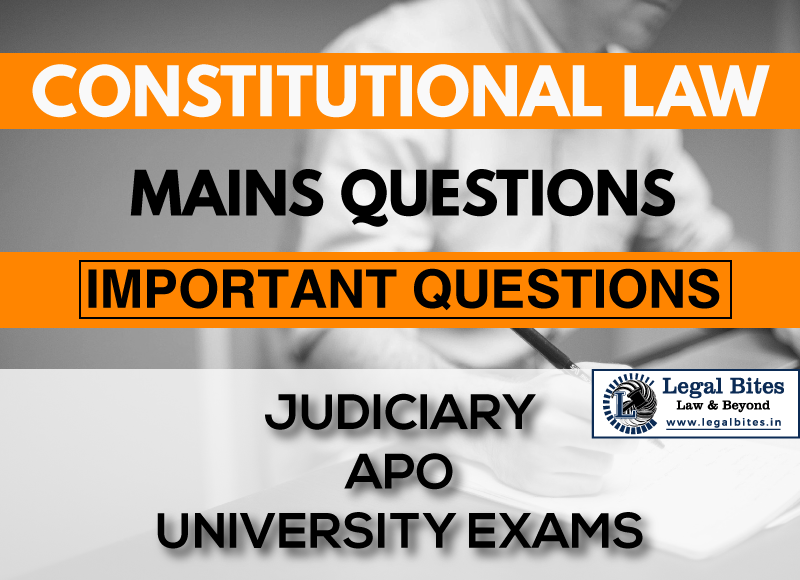Write a note on Article 368 and the Supreme Court of India.
Question: Write a note on Article 368 and the Supreme Court of India. [BJS 2006] Find the answer to the mains question only on Legal Bites. [Write a note on Article 368 and the Supreme Court of India.] Answer Article 368 of the Indian Constitution enshrines the powers of Parliament to amend the Constitution and its procedure. Though… Read More »

Question: Write a note on Article 368 and the Supreme Court of India. [BJS 2006] Find the answer to the mains question only on Legal Bites. [Write a note on Article 368 and the Supreme Court of India.] Answer Article 368 of the Indian Constitution enshrines the powers of Parliament to amend the Constitution and its procedure. Though our Constitution grants the power of bringing amendment on the Parliament, it is not absolute and the limitation of Parliament’s power of amendment is a...
Question: Write a note on Article 368 and the Supreme Court of India. [BJS 2006]
Find the answer to the mains question only on Legal Bites. [Write a note on Article 368 and the Supreme Court of India.]
Answer
Article 368 of the Indian Constitution enshrines the powers of Parliament to amend the Constitution and its procedure. Though our Constitution grants the power of bringing amendment on the Parliament, it is not absolute and the limitation of Parliament’s power of amendment is a basic feature of the constitution. The procedural limitation on the power of amendment is laid down in Article 368 itself and the Supreme Court has the authority to check upon the constitutional validity of an amendment through its power of judicial review.
To preserve the ideals and philosophy of the original constitution, the Supreme Court has laid down the basic structure doctrine. The doctrine allows the Supreme Court to strike down any amendments that may alter the ‘basic structure’ of the constitution. This doctrine is only applicable to the situation of Constitutional Amendments. Through judicial pronouncements, SC has curbed the Parliament’s power to bring an amendment to Basic features of the constitution.
The concept of the Basic Structure Doctrine was recognized for the first time in the landmark case of Kesavananda Bharati v. State of Kerala [(1973) 4 SCC 22] case, in which the Supreme Court declared that Article 368 did not enable Parliament to alter the basic structure or framework of the Constitution and parliament could not use its amending powers under Article 368 to ‘damage’, ’emasculate’, ‘destroy’, ‘abrogate’, ‘change’ or ‘alter’ the ‘basic structure’ or framework of the constitution.
In Indira Nehru Gandhi v. Raj Narayan [AIR 1975 SC 2299] case, once again the basic structure concept was reaffirmed. The Supreme Court applied the same theory and struck down the 4th clause of Article 329 A on the ground that the Amendment is beyond the power of the parliament and it destroyed the basic structure of the Constitution. The Amendment was made regarding the jurisdiction of all courts including the Supreme Court, regarding the dispute of an election of the Prime Minister of India.
Some feature which was regarded by the court as fundamental and, thus non-amendable are included by the Supreme Court into the ‘basic features’ list –
- Supremacy of the Constitution;
- Republican and democratic form of government;
- Secular character of the Constitution;
- Separation of Powers;
- Federal character of the Constitution.
- The Rule of Law
- Judicial Review
- Democracy, which implies free and fair election
- Limited Power of Parliament to amend the Constitution
- Harmony and Balance between fundamental rights and directive principles
- Fundamental rights in certain cases
Important Mains Questions Series for Judiciary, APO & University Exams
- Constitutional Law Mains Questions Series Part-I
- Constitutional Law Mains Questions Series Part-I
- Constitutional Law Mains Questions Series Part-II
- Constitutional Law Mains Questions Series Part-IV
- Constitutional Law Mains Questions Series Part-V
- Constitutional Law Mains Questions Series Part-VI
- Constitutional Law Mains Questions Series Part-VII
- Constitutional Law Mains Questions Series Part-VIII
- Constitutional Law Mains Questions Series Part-IX
- Constitutional Law Mains Questions Series Part-X
Admin Legal Bites
Legal Bites Study Materials correspond to what is taught in law schools and what is tested in competitive exams. It pledges to offer a competitive advantage, prepare for tests, and save a lot of money.
